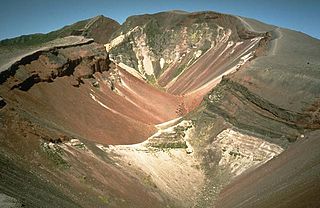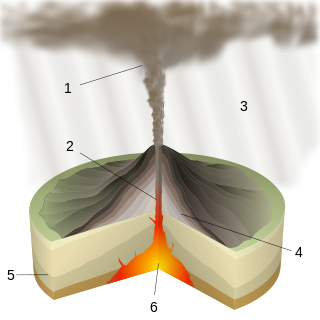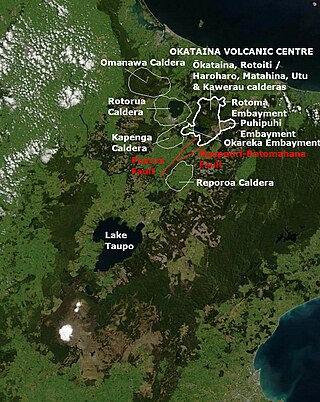
The Taupō Volcanic Zone (TVZ) is a volcanic area in the North Island of New Zealand. It has been active for at least the past two million years and is still highly active.

Mount Tarawera is a volcano on the North Island of New Zealand within the older but volcanically productive Ōkataina Caldera. Located 24 kilometres southeast of Rotorua, it consists of a series of rhyolitic lava domes that were fissured down the middle by an explosive basaltic eruption in 1886. While the 1886 eruption was basaltic, study has shown there was only a small basalt component to the previous recent rhyolitic predominant eruptions. This eruption was one of New Zealand's largest historical eruptions, and killed an estimated 120 people. The fissures run for about 17 kilometres (11 mi) northeast–southwest.

Plinian eruptions or Vesuvian eruptions are volcanic eruptions marked by their similarity to the eruption of Mount Vesuvius in 79 AD, which destroyed the ancient Roman cities of Herculaneum and Pompeii. The eruption was described in a letter written by Pliny the Younger, after the death of his uncle Pliny the Elder.

Lake Rotorua is the second largest lake in the North Island of New Zealand by surface area, and covers 79.8 km2. With a mean depth of only 10 metres it is considerably smaller than nearby Lake Tarawera in terms of volume of water. It is located within the Rotorua Caldera in the Bay of Plenty Region.

Lake Rotoiti is a lake in the Bay of Plenty region of New Zealand. It is the northwesternmost in a chain of lakes formed within the Okataina Caldera. The lake is close to the northern shore of its more famous neighbour, Lake Rotorua, and is connected to it via the Ohau Channel. It drains to the Kaituna River, which flows into the Bay of Plenty near Maketu.
The region around the city of Rotorua, in New Zealand's North Island, contains several lakes which have a total area of about 250 square kilometres. The term Rotorua lakes is ambiguous as it has been used historically for a New Zealand administrative area. From biggest to smallest, these are Lake Rotorua, Lake Tarawera, Lake Rotoiti, Lake Rotomā, Lake Okataina, Lake Rotoehu, Lake Rotomahana, Lake Rerewhakaaitu, Lake Rotokākahi, Lake Okareka and Lake Tikitapu. There are also smaller lakes including: Lake Okaro, Lake Rotokawa, Lake Rotokawau and Lake Rotongata. Most of the lakes have formed due to volcanic activity and some have current geothermal activity. The region is part of the Taupō Volcanic Zone, the world's most active area of explosive silicic volcanic activity in geologically recent time.

The 1886 eruption of Mount Tarawera was a violent volcanic eruption that occurred in the early hours of 10 June 1886 at Mount Tarawera, near Rotorua on New Zealand's North Island. The eruption reached an estimated volcanic explosivity index (VEI) of 5 and killed an estimated 120 people, making it the largest and deadliest in New Zealand during the past 500 years, a period that includes the entirety of European history in New Zealand.

Lake Rotokawau is a small volcanic lake 4.1 km (2.5 mi) east of Lake Rotorua in the Bay of Plenty region of New Zealand's North Island. The name is also used for lakes in the Kaipara District, Chatham Islands, on Aupouri Peninsula and near Lake Waikare in Waikato. Access is via Lake Rotokawau Road, from SH30 at Tikitere. The lake is owned and managed by Ngāti Rangiteaorere.
The Haroharo Caldera is a 26 by 16 km postulated volcanic feature in Taupō Volcanic Zone of the North Island, New Zealand within the larger and older Ōkataina Caldera. Since 2010 further studies have tended to use the terms Haroharo vent alignment, Utu Caldera, Matahina Caldera, Rotoiti Caldera and a postulated Kawerau Caldera to the features assigned to it. However the name is used in the peer reviewed literature to summarise and group these features based on gravitational and magnetic features.

The Kapenga Caldera in New Zealand’s Taupō Volcanic Zone lies in a lowland area immediately south of Lake Rotorua through the Hemo Gap in the Rotorua Caldera rim. Features of the caldera have developed over a period of about 900,000 years. At some time more than 60,000 years ago, Lake Rotorua drained through the Hemo Gap, and part of the Kapenga Caldera floor was likely occupied by a lake, which has been referred to as Kapenga.

The relatively small Rotomā Caldera is in the Taupō Volcanic Zone in the North Island of New Zealand.

The Paeroa Fault is a seismically active area in the Taupō District, Waikato Region of the central North Island of New Zealand.

The Ōkāreka Embayment is a volcanic feature in Taupo Volcanic Zone of New Zealand. Its most significant recent volcanic eruption was about 15,700 years ago and this deposited the widespread Rotorua tephra that reached beyond Auckland.

The Horohoro Fault is in the old Taupō Rift of the central North Island of New Zealand and is associated with the spectacular Horohoro Cliffs.
The Taupō Fault Belt contains many almost parallel active faults, and is located in the Taupō Rift of the central North Island of New Zealand geographically between Lake Taupō and the lakes of Rotorua, Tarawera, Rotomahana and Rerewhakaaitu. The potential active fault density is very high, with only 0.1 to 1 km separating the north-east to south-west orientated normal fault strands on detailed mapping of part of the belt. The Waikato River bisects the western region of the belt.

The Tikitere Graben is a intra-rift graben in the North Island of New Zealand that contains the Ohau Channel, which drains Lake Rotorua into Lake Rotoiti with a minimal drop between the lakes.
Much of the volcanic activity in the northern portions of the North Island of New Zealand is recent in geological terms and has taken place over the last 30 million years. This is primarily due to the North Island's position on the boundary between the Indo-Australian and Pacific plates, a part of the Pacific Ring of Fire, and particularly the subduction of the Pacific plate under the Indo-Australian plate. The activity has included some of the world's largest eruptions in geologically recent times and has resulted in much of the surface formations of the North Island being volcanic as shown in the map.
The Manawahe Fault line is a seismically active area in the Bay of Plenty Region of the central North Island of New Zealand with the potential to be involved with other faults in an 7.0 event.

The Puhipuhi Embayment is a volcanic feature in Taupo Volcanic Zone of New Zealand associated with the collapse of the Ōkataina Caldera wall to its west. Its latest significant volcanic eruption was about 31,500 years ago and this dating required a reassessment of recent activity at the Eastern extension of the Tarawera vent alignment.
The Rotoiti Caldera is a postulated, mainly infilled sub caldera of the Ōkataina Caldera based upon gravitational and magnetic evidence. While bathymetry of Lake Rotoiti is consistent with volcanic vents being present, they could be in an area of collapse subsidence outside the north western margins of the Rotoiti Caldera itself.
















